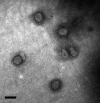First isolation of cytopathogenic bovine torovirus in cell culture from a calf with diarrhea
- PMID: 17567770
- PMCID: PMC2044491
- DOI: 10.1128/CVI.00475-06
First isolation of cytopathogenic bovine torovirus in cell culture from a calf with diarrhea
Abstract
A cytopathogenic virus (designated the Aichi/2004 strain) was isolated in a human rectal adenocarcinoma cell line (HRT-18) from the ileum contents of a calf with diarrhea. Oval and elongated particles, approximately 100 to 170 nm in diameter, with club-shaped projections were seen in the infected culture supernatant, and torovirus-like (tubular and torus nucleocapsid) structures were seen in the infected cells by electron microscopy. An antiserum against bovine torovirus (BToV) reacted with the infected cells by immunofluorescence and neutralized the isolate. However, antisera against bovine coronavirus (BCV) failed to react with the infected cells by immunofluorescence or did not neutralize the isolate. Further, the isolate was positive for BToV by reverse transcription-PCR (RT-PCR) targeting fragments of the nucleocapsid (N), membrane (M), and spike (S) genes. Comparison of the nucleotide sequences of the PCR products with those of the published N, M, and S genes (476 to 497, 672, and 687 to 690 nucleotides, respectively) of toroviruses showed high sequence identities (up to 99.4%, 98.7%, and 94.9% for the N, M, and S genes, respectively) between the isolate and BToVs. In contrast, the isolate was negative for BCV by RT-PCR. In a serological survey of serum samples from 355 calves at 33 farms, 92% of calves were positive for neutralizing antibodies to the isolate. These results indicate that the isolate in this study was BToV and that BToV infection might be common in cattle in Japan. To our knowledge, this is the first isolation of BToV in tissue culture.
Figures





References
MeSH terms
Substances
Associated data
- Actions
- Actions
- Actions
LinkOut - more resources
Full Text Sources
Medical

